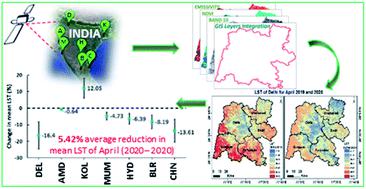当前位置:
X-MOL 学术
›
Environ. Sci.: Processes Impacts
›
论文详情
Our official English website, www.x-mol.net, welcomes your
feedback! (Note: you will need to create a separate account there.)
COVID-19 lockdowns induced land surface temperature variability in mega urban agglomerations in India
Environmental Science: Processes & Impacts ( IF 4.3 ) Pub Date : 2020-12-10 , DOI: 10.1039/d0em00358a Dhruv Nanda 1, 2, 3, 4 , Deepk R. Mishra 5, 6, 7, 8 , Debadatta Swain 1, 2, 3, 4
Environmental Science: Processes & Impacts ( IF 4.3 ) Pub Date : 2020-12-10 , DOI: 10.1039/d0em00358a Dhruv Nanda 1, 2, 3, 4 , Deepk R. Mishra 5, 6, 7, 8 , Debadatta Swain 1, 2, 3, 4
Affiliation

|
The COVID-19 pandemic forced a nationwide lockdown in India for months when close to 1.3 billion people were confined to their homes. An abrupt halt in the majority of the urban activities reduced the generation of anthropogenic heat which often exacerbates the Urban Heat Island (UHI) effect in the urban pockets of the country. We studied the lockdown impact on seven highly populated and polluted mega urban agglomerations across India, namely Delhi, Ahmedabad, Hyderabad, Kolkata, Mumbai, Bengaluru and Chennai, using near-anniversary Landsat 8 data. The results revealed that the lockdowns have improved the air quality and reduced the Land Surface Temperature (LST) and hence the UHI effect over these cities. Each of the cities experienced an improved Air Quality Index (AQI) ranging from 18 to 151 units except Chennai (with a marginal 8 units increase in AQI), a decrease in mean LST in the range of 0.27 °C to 7.06 °C except Kolkata which showed an increment by ∼4 °C, and a reduction in daily averaged air temperature ranging from 0.3 °C to 10.88 °C except Hyderabad which witnessed an increase of 0.09 °C during the lockdown (April 2020) compared to the previous years (April 2019 and 2018). Delhi exhibited the maximum positive impact of the lockdown in all aspects with two-fold improved air quality, and Ahmedabad showed the least improvement. In addition to the variations in regional land use and land cover and proportion of essential industries that remained operational throughout the lockdown, the geographic location, topography, local meteorology and climate were some of the other factors also responsible for either aiding or overcompensating the large scale LST variabilities observed in these cities. These results hint at an unprecedented opportunity to evaluate the effectiveness of periodic planned lockdowns as a possible mitigating measure to reduce LST spikes and degraded air quality in urban areas in the future.
中文翻译:

COVID-19锁定导致印度巨型城市群的地表温度变化
COVID-19大流行迫使印度全国封锁数月之久,当时将近13亿人被限制在家中。大多数城市活动的突然停止减少了人为热量的产生,这通常加剧了该国城市地区的城市热岛效应。我们使用近周年的Landsat 8数据研究了锁定对印度七个人口稠密且污染严重的大型城市群的影响,这些城市群是德里,艾哈迈达巴德,海得拉巴,加尔各答,孟买,班加罗尔和金奈。结果表明,封锁措施改善了空气质量,降低了地表温度(LST),因此对这些城市产生了UHI效应。除钦奈以外,每个城市的空气质量指数(AQI)均提高了18至151个单位(空气质量指数增加了8个单位),除加尔各答以外,平均LST降低了0.27°C至7.06°C气温升高了约4°C,日平均气温降低了0.3°C至10.88°C,但海德拉巴的锁定期间(2020年4月)与往年相比增加了0.09°C( 2019年4月和2018年4月)。德里在所有方面都表现出封锁的最大积极影响,空气质量提高了两倍,而艾哈迈达巴德则表现出最少的改善。除了区域内土地使用和土地覆盖的变化以及在整个禁区期间仍在运转的重要行业的比例,地理位置,地势,其他当地因素和气候也是导致这些城市中观测到的大规模LST变异的辅助因素或过度补偿的原因。这些结果暗示了前所未有的机会来评估定期计划的锁定措施的有效性,以此作为减轻将来城市地区LST峰值和空气质量下降的可能缓解措施。
更新日期:2020-12-24
中文翻译:

COVID-19锁定导致印度巨型城市群的地表温度变化
COVID-19大流行迫使印度全国封锁数月之久,当时将近13亿人被限制在家中。大多数城市活动的突然停止减少了人为热量的产生,这通常加剧了该国城市地区的城市热岛效应。我们使用近周年的Landsat 8数据研究了锁定对印度七个人口稠密且污染严重的大型城市群的影响,这些城市群是德里,艾哈迈达巴德,海得拉巴,加尔各答,孟买,班加罗尔和金奈。结果表明,封锁措施改善了空气质量,降低了地表温度(LST),因此对这些城市产生了UHI效应。除钦奈以外,每个城市的空气质量指数(AQI)均提高了18至151个单位(空气质量指数增加了8个单位),除加尔各答以外,平均LST降低了0.27°C至7.06°C气温升高了约4°C,日平均气温降低了0.3°C至10.88°C,但海德拉巴的锁定期间(2020年4月)与往年相比增加了0.09°C( 2019年4月和2018年4月)。德里在所有方面都表现出封锁的最大积极影响,空气质量提高了两倍,而艾哈迈达巴德则表现出最少的改善。除了区域内土地使用和土地覆盖的变化以及在整个禁区期间仍在运转的重要行业的比例,地理位置,地势,其他当地因素和气候也是导致这些城市中观测到的大规模LST变异的辅助因素或过度补偿的原因。这些结果暗示了前所未有的机会来评估定期计划的锁定措施的有效性,以此作为减轻将来城市地区LST峰值和空气质量下降的可能缓解措施。











































 京公网安备 11010802027423号
京公网安备 11010802027423号